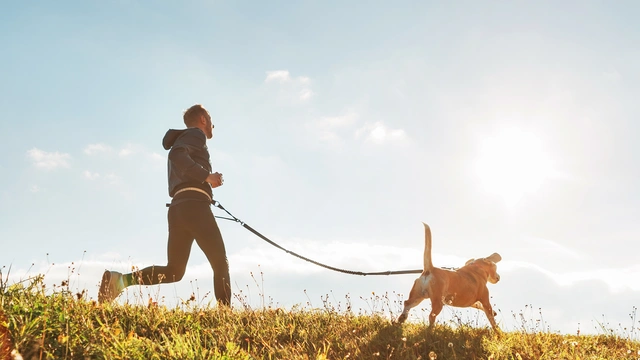
Running with your dog
Most of us have had fun running with our dogs, whether it’s just a game of chase around the garden or a jog to get home in time for dinner. But if you regularly run or are planning to do so, having a running buddy can be a great way to spend fun time together, while keeping you both fit. If you’re considering this, read on.
Of course, this type of activity won’t suit some breeds of dog. For example, brachycephalic dogs – those with short muzzles – such as Bulldogs or Pugs – are not going to be able to cope with more than a short distance. Even if you have a breed known for their endurance and potentially ideally suited to running for long periods of time, remember that each dog is an individual and, just as many of your friends would be horrified at the thought of going out for a run, so might your dog.
Wait until your dog is mature
You should wait until your dog is mature before considering running for long distances. Check with your vet, but that’s at about 1 – 1.5 years old. Young puppies’ bones are still growing, and although they may race around for short periods at a time, running at a forced pace isn’t good for them.
Bear in mind that much of a dog’s enjoyment of a walk comes from having time to sniff, so make sure they have the opportunity to do so at other times.
Ease your dog into it
If you’re contemplating long runs, do ease your dog into it. Like us, they need to train to build up their strength. Even if your dog tends to spend much of his off-lead time on walks racing around, that will be at his own pace and likely with many stops and starts as something on the ground attracts his interest. This is very different from keeping pace with you for a long period of time.
Teach your dog to match your pace
It's also worth thinking about what training will help make your runs together safe and enjoyable. If your dog constantly swaps from one side of you to the other, pulls on the lead or is likely to be distracted by a passing squirrel, it’s not just a nuisance but also potentially dangerous as they are likely to trip you up or pull you over.
If your dog isn’t trained to walk nicely to heel, you’ll need to teach them that whatever distractions there are, their job is to keep to one side of you matching your pace.
Of course, if you run somewhere your dog can be off lead and they always keep close to you, this may not be something you need to address.
Directional cues
Is your dog reliable about coming back when called, even if there are distractions? If they are going to be off lead, it’s important you work on training a good recall. Another useful cue to teach is the so-called ‘automatic sit’: that is, you teach your dog that when you stop, they should sit without you giving them a verbal cue. This is especially helpful if you’re running through streets and likely to have to stop frequently before crossing a road and continuing with your run.
Although, with experience, your dog is likely to be aware of any movement you make to the left or right, teaching them some directional cues as well as cues to indicate you’re about to speed up or slow down, can be very helpful, especially if your dog tends to run a little in front of you.
Training & Equipment
Next, think about getting your dog fit for longer distances. If you’re just starting a new running regime yourself, you can begin to build up the necessary endurance together but if you already go for very long runs, don’t forget you’ll have to take your time getting your dog fit enough. Either go for short runs to begin with or cover the distance with a mix of running and walking. Like you, your dog needs to warm up before a long run and cool down afterwards.
Think also about getting the right equipment. If you clip the lead to your dog’s collar, it’s especially important they’re keeping pace with you and the lead is loose and not pulling on their collar which will be uncomfortable and potentially damaging for your dog. Similarly, if you use a harness, make sure you find one that fits comfortably and doesn’t restrict your dog’s freedom of movement when running as this could cause longer-term problems. For your own comfort and freedom of movement you may find that being hands-free is preferable so look for a lead that attaches to a belt or over the shoulder.
Make sure to bring water for your dog
Dogs don’t cool off by sweating as we do. They mainly get cooler by panting which means they are likely to get very thirsty. So, as well as your own water supply, make sure you have a suitable container to give some to your dog.
Are you planning to run when it’s getting dark outside?
If so, it’s a good idea to make your dog more visible with the use of a LED collar.
Do you like to track your own running data?
You can do this for your dog as well. There are a number of small products around that attach to your dog’s collar and track their activity. Over time, you could perhaps use the data to get an idea of how much a long run affects their activity for the rest of the day.
Finally, if you and your dog are really enjoying running together you may want to research the increasingly popular dog sport Canicross – cross-country running with dogs!
For more training advice, please visit our dog coach Vicky Carne's website.



